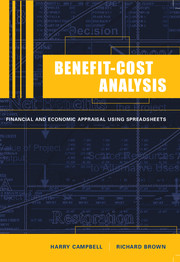Book contents
- Frontmatter
- Contents
- List of figures
- List of tables
- Preface
- Acknowledgements
- 1 Benefit-Cost Analysis: Introduction and Overview
- 2 Investment Appraisal: Principles
- 3 Investment Appraisal: Decision-Rules
- 4 Private Benefit-Cost Analysis: Financial Analysis
- 5 Efficiency Benefit-Cost Analysis
- 6 Calculating the Net Benefits to the Referent Group
- 7 Consumer and Producer Surplus in Benefit-Cost Analysis
- 8 Valuing Traded and Non-traded Commodities in Benefit-Cost Analysis
- 9 Incorporating Risk in Benefit-Cost Analysis
- 10 The Social Discount Rate, Cost of Public Funds, and the Value of Information
- 11 Weighting Net Benefits to Account for Income Distribution
- 12 Valuation of Non-marketed Goods
- 13 Economic Impact Analysis
- 14 Writing the Benefit-Cost Analysis Report
- Appendix 1 Case Study Assignment
- Appendix 2 Discount and Annuity Tables
- Index
10 - The Social Discount Rate, Cost of Public Funds, and the Value of Information
Published online by Cambridge University Press: 05 September 2012
- Frontmatter
- Contents
- List of figures
- List of tables
- Preface
- Acknowledgements
- 1 Benefit-Cost Analysis: Introduction and Overview
- 2 Investment Appraisal: Principles
- 3 Investment Appraisal: Decision-Rules
- 4 Private Benefit-Cost Analysis: Financial Analysis
- 5 Efficiency Benefit-Cost Analysis
- 6 Calculating the Net Benefits to the Referent Group
- 7 Consumer and Producer Surplus in Benefit-Cost Analysis
- 8 Valuing Traded and Non-traded Commodities in Benefit-Cost Analysis
- 9 Incorporating Risk in Benefit-Cost Analysis
- 10 The Social Discount Rate, Cost of Public Funds, and the Value of Information
- 11 Weighting Net Benefits to Account for Income Distribution
- 12 Valuation of Non-marketed Goods
- 13 Economic Impact Analysis
- 14 Writing the Benefit-Cost Analysis Report
- Appendix 1 Case Study Assignment
- Appendix 2 Discount and Annuity Tables
- Index
Summary
Introduction
In this Chapter we consider three issues each of which may call for a modification of the following simple net present value rule: in the absence of risk, undertaking any project with a positive net present value (NPV), calculated using the appropriate shadow-prices and discounting at the market rate of interest, will contribute to economic efficiency.
Firstly, the concept of social time preference reflects the view that the market rate of interest does not accurately reflect society's preference for present as opposed to future consumption, and that a discount rate based on a social time preference rate should be used to calculate NPVs from a public interest viewpoint. For reasons which will be discussed below, the social time preference rate is usually judged to be lower than the market rate of interest.
Secondly, the concept of social opportunity cost is based on the notion that, because of tax-induced distortions to the pattern of resource allocation, the opportunity cost to the economy of raising public funds for government expenditures is higher than the nominal amount raised. This suggests that a public project should have a present value of benefits sufficiently large not only to offset project costs (the NPV>0 rule), but also to offset the premium on the cost of public funds if the project is to make a net contribution to efficiency.
Thirdly, the fact that a project has a NPV>0 does not necessarily imply that now is the most efficient time to implement it. Because additional information about the project variables - prices, costs etc. - may accrue in the future there could be an advantage to keeping open the option of undertaking the project.
- Type
- Chapter
- Information
- Benefit-Cost AnalysisFinancial and Economic Appraisal using Spreadsheets, pp. 221 - 237Publisher: Cambridge University PressPrint publication year: 2003



